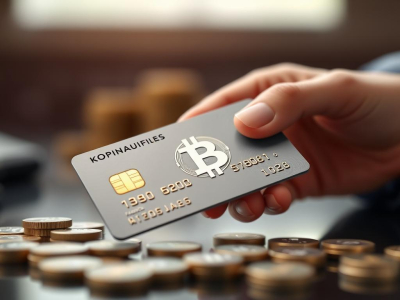
To experience the full potential of cryptocurrency, using a dedicated card for your daily transactions is an effective approach. This method grants access to digital assets in real-time while ensuring seamless payment experiences across various platforms.
Begin by setting up a secure wallet linked to your cryptocurrency card. Choose a wallet that prioritizes security, utilizing two-factor authentication and encryption protocols. This precaution will safeguard your funds while you engage in everyday purchases.
Consider using your card at local merchants who accept crypto payments or through digital marketplaces. Each transaction made with the card allows for instant conversion rates from your cryptocurrency holdings to fiat currency, enabling you to partake in traditional commerce without missing out on the benefits of your digital investments. Utilize exchanges that offer competitive rates for converting currencies directly through the card for optimal financial management.
This hands-on approach not only enhances your understanding of cryptocurrency mechanics but also solidifies its practicality as a modern payment solution. By living a day exclusively with a cryptocurrency card, you gain insights into the future of finance.
Choosing the Right Card
Prioritize cards that offer low transaction fees for spending with cryptocurrency. Look for options that seamlessly integrate with your existing digital wallet, allowing swift access to funds without unnecessary delays.
Security should be paramount; select a card with robust encryption and two-factor authentication features. This ensures that your transactions remain secure, protecting your assets from potential breaches.
Evaluate the supported cryptocurrencies. A versatile card allows exchanges between various coins, enhancing your ability to manage and spend effectively. Cards that provide real-time conversion rates can also optimize your transactions.
Research user reviews regarding customer service quality. Quick resolution of issues is vital when dealing with financial transactions, especially in the cryptocurrency space where timeliness can affect value significantly.
Lastly, consider additional perks such as cash back or rewards on spending. These incentives can add value to your daily transactions while using cryptocurrency, turning routine purchases into advantageous opportunities.
Where to Spend Cryptocurrency
Utilize cryptocurrency for various transactions across diverse sectors. Here are specific categories and examples:
- Retail:
- Online stores like Overstock and Newegg accept Bitcoin and other cryptocurrencies.
- Physical locations such as select Starbucks and Home Depot now support crypto payments via cards.
- Travel:
- Booking platforms like Expedia allow users to pay with Bitcoin for hotel reservations.
- Airtreks offers flights purchasable with cryptocurrency, enhancing travel access.
- Food & Beverage:
- Many restaurants and cafes in major cities accept crypto through payment processors.
- Grubhub allows for cryptocurrency transactions via third-party services linked to your card.
- Entertainment:
- Platforms like Twitch let users donate or subscribe using digital currencies.
- Cinemas in select areas are beginning to accept Bitcoin for ticket purchases.
- Gift Cards:
- Services like Bitrefill enable purchasing gift cards from well-known retailers using cryptocurrency.
- This approach broadens the range of spending options beyond direct acceptance.
The security of transactions when using a cryptocurrency card is paramount. Ensure your wallet is secure, employing two-factor authentication wherever possible. Regularly monitor transactions to safeguard against unauthorized use. Accessing crypto-friendly businesses through directories can streamline the spending process, making it more efficient and user-friendly.
This guide showcases practical avenues for spending cryptocurrency effectively while maintaining strong security practices around your digital assets.
Tracking Your Expenses
Utilize a dedicated cryptocurrency wallet that allows for real-time tracking of your transactions. This approach ensures you have a clear view of your spending habits throughout the day. Many wallets offer built-in analytics that categorize your expenses, providing valuable insights into where your money is going.
Set up alerts for significant transactions or spending limits on your card. This feature enhances security and helps prevent overspending in volatile markets. By receiving notifications, you can stay aware of large purchases and adjust your budget accordingly.
Consider using software or apps that integrate with your cryptocurrency wallet to consolidate transaction data across multiple platforms. This will allow for easier management of digital payments made with different cryptocurrencies.
Keep an eye on the exchange rates when making purchases. Cryptocurrency values fluctuate rapidly; understanding these changes can help you decide when to spend or hold onto assets. Some wallets provide real-time exchange rate updates, allowing for informed decisions at the moment of payment.
Review your spending weekly or monthly to identify patterns in your cryptocurrency usage. Look for recurring payments or subscriptions that could be adjusted or eliminated. Regular analysis not only sharpens financial awareness but also aids in optimizing future transactions.
Always ensure that security measures are in place, especially when tracking sensitive financial information. Enable two-factor authentication on both your card and wallet applications to safeguard against unauthorized access.
Managing Daily Transactions
Utilize a cryptocurrency card that allows for seamless transactions across various platforms. Ensure your wallet is linked directly to the card, enabling instant access to funds for daily spending.
Before making payments, verify transaction fees associated with your chosen card. Some cards may charge higher fees when converting cryptocurrency to fiat currency at the point of sale. Review fee structures on the provider's website or app for transparency.
For enhanced security, set up two-factor authentication on your wallet and payment methods. This protects against unauthorized access and potential fraud during transactions.
Keep track of your daily transactions using a dedicated app or tool that syncs with your cryptocurrency wallet. Monitoring these details aids in budgeting and prevents overspending.
When utilizing exchanges for converting cryptocurrency, select platforms that offer competitive rates and low fees. Timing your trades can significantly impact the amount you receive, so stay informed about market fluctuations.
Maintain a record of all transactions for tax purposes, as many jurisdictions require documentation of cryptocurrency spending. Utilize tools that automatically generate reports from your wallet activity to simplify this process.


You can be the first!